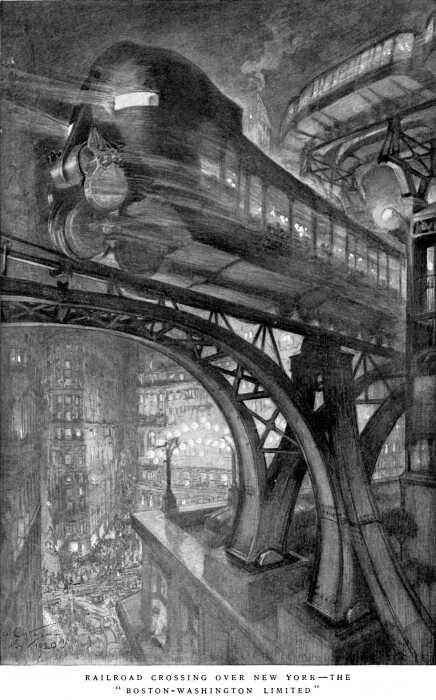 THE
EDGE OF THE FUTURE IN SCIENCE THE
EDGE OF THE FUTURE IN SCIENCE
Munsey's Magazine
TRANSPORTATION AND THE GYROSCOPE
LOUIS BRENNAN'S MONO-RAIL CAR
BY CLEVELAND MOFFETT
AUTHOR OF "A KING IN RAGS," ETC.
ILLUSTRATED WITH PHOTOGRAPHS AND WITH DRAWINGS BY ANDRE
CASTAIGNE
On the 8th of May 1907, Mr. Louis Brennan exhibited, at a meeting
of the Royal Society in London, a piece of mechanism which stirred
the imagination of every beholder and, reported next morning by
the newspapers, aroused the amazed interest of the world. This
invention consists of a car that runs on a single rail, standing
erect like a bicycle when in motion, but, unlike the bicycle,
remaining equally stable when at rest. If a weight is placed on
one edge of the car, that side rises higher instead of being lowered.
If you push against the side with your hand, the mysterious creature—you
feel that it must be endowed with life—is actually felt to
push back as if resenting the affront. If the track on which it
runs consisting of an ordinary gas-pipe or a cable of wire is
curved, even very sharply, the car follows the curve without difficulty,
and, in apparent defiance of ordinary laws of motion, actually
leans inward, as a bicycle-rider leans, under the same circumstances,
instead of careening outward, as one might expect.
It is a curious mechanism, this new car with its four wheels
set in line, bicycle fashion, running steadily along; but strangest
of all it seems when it stands poised and perfectly still on its
tight-rope. As stably poised it stands there as if it had two
rails beneath it instead of a single wire; and there is nothing
about it to suggest an explanation of the miracle, except that
there comes from within the car the murmur of whirling wheels.
The mysterious wheels in question would be found, if we could
look within the structure of the car, to be two in number, arranged
quite close together on either side of the center of the car.
They are two small flywheels, in closed cases, revolving in opposite
directions, each propelled by an electric motor. These are the
wonder-workers. They constitute the two-lobed brain—or, if
you prefer, the double-chambered heart—of the strange organism.
All the world has learned to call them gyroscopes. The vehicle
that they balance may conveniently be termed a gyro-car, a name
that has the sanction of the inventor himself Louis Brennan, already
a man of international reputation as an inventor.
The Lifelong Dream of an Inventor
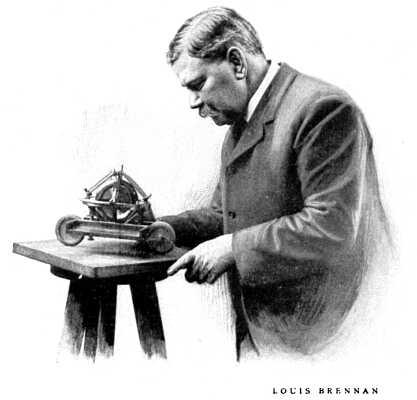 Mr. Brennan is an Irishman, born
in Castlebar fifty-five years ago, although you would never believe
it, for an active out-of-door life has kept him strong and young.
As a child he had, what he has never lost, the power of wonder.
He wondered at the vastness and mystery of the Australian bush
when, at the age of fourteen, he journeyed through it. He fancied
this vast silent region crowded with cities and busy with the
activities of man; and he tried to conjecture by what means a
great future population would be moved about over it easily and
swiftly. As he grew older, Brennan puzzled more and more over
transportation questions. How, he asked himself, when the whole
world should be crowded with people, would they all be able to
get from place to place? This question kept recurring to him through
his boyhood and young manhood, and at last became the problem
of his life. For his own peace of mind he had to answer it. Mr. Brennan is an Irishman, born
in Castlebar fifty-five years ago, although you would never believe
it, for an active out-of-door life has kept him strong and young.
As a child he had, what he has never lost, the power of wonder.
He wondered at the vastness and mystery of the Australian bush
when, at the age of fourteen, he journeyed through it. He fancied
this vast silent region crowded with cities and busy with the
activities of man; and he tried to conjecture by what means a
great future population would be moved about over it easily and
swiftly. As he grew older, Brennan puzzled more and more over
transportation questions. How, he asked himself, when the whole
world should be crowded with people, would they all be able to
get from place to place? This question kept recurring to him through
his boyhood and young manhood, and at last became the problem
of his life. For his own peace of mind he had to answer it.
And, first, he saw clearly that the present system of railroads
could not permanently satisfy the needs and desires of our advancing
civilization. We must have something quite different from the
harrow, pounding boxes in which we have been accustomed to travel—something
much bigger and better. He soon decided that the trouble with
existing cars and locomotives lay in the practical impossibility
of making them run smoothly on two rails. One wears more than
the other; one sags more; one spreads a little in, the other a
little out, with the result that the right-hand wheels and the
left-hand wheels of our modern railway-trains are constantly trying
to go in different directions, and cars and locomotives are subjected
to jolts and side-thrusts—partially relieved by springs,
but nevertheless disturbing to the passenger's comfort, and often
a menace to his safety. Any one who has ridden on a locomotive
or a freight-car knows how violent these side-thrusts really are.
The Single Rail an Essential of Ideal Travel
So, evidently, the ideal railway-train must run on one rail,
not on two; Brennan came to this conclusion years ago, but the
question was, how to make a train do this. For a long time he
considered a single, overhead rail with the train suspended from
it but he saw that such a system would require a continuous supporting
structure, and, while it would doubtless solve the problem of
smooth running, it could never come into general use, because
of its prohibitive cost.
There remained, then, only the device of a single rail under
the train; it must be that or nothing. But could a train be
made to balance itself on a single rail? Tightrope walkers balance
themselves on ropes, men balance themselves on bicycles, but a
locomotive on a single rail—it seemed like a foolish dream;
yet, obstinately, Brennan's thoughts came back to it—year
after year came back to it. There must be some way of doing this
thing. The comfort of mankind required that a locomotive should
balance itself on a single rail—yes, and draw a train after
it.
Early in his life, Brennan thought about the ordinary spinning
top, and noted that so long as it spins it has the very balancing
power that he was seeking. He saw that if you kept a top spinning
indefinitely (say by electricity) it would balance itself indefinitely
on a point, and that this would be true even if you made the top
large and heavy. Brennan bought various kinds of tops, and made
new kinds, and experimented with them and puzzled over them for
hours and weeks and years. One result of his puzzling was the
steerable torpedo, the invention of which he sold some years ago
to the British government for $550,000—the largest sum of
money ever paid by a government for any invention; for the steering-gear
of this is based upon the principle of the revolving wheel.
The Laws of the Action of the Gyroscope
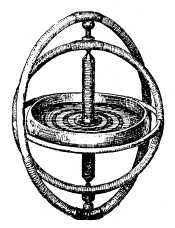 Now, according to a familiar
law of physics, any body once set spinning persists with all its
power in spinning in one plane. Tops, children's hoops, and all
spinning wheels, of whatever sort, have made this law familiar
to all civilized mankind; the working of the law in astronomy
is a part of the staple information of every man of education.
This familiar law is the first principle of Brennan's invention. Now, according to a familiar
law of physics, any body once set spinning persists with all its
power in spinning in one plane. Tops, children's hoops, and all
spinning wheels, of whatever sort, have made this law familiar
to all civilized mankind; the working of the law in astronomy
is a part of the staple information of every man of education.
This familiar law is the first principle of Brennan's invention.
From the top Brennan turned to study a more scientific instrument—the
gyroscope. The gyroscope is simply a metal wheel, delicately poised
within two metal rings, so placed that the wheel is free to turn
in any direction as it spins. It is an invention made more than
half a century ago for use in the study of the laws of revolving
bodies. The most familiar law illustrated by it is the tendency
of such bodies to continue spinning in the direction that has
once been given them. A small brass gyro-scope-wheel that you
could move, while at rest, as easily as you move your watch, will
develop, once it starts whirling, an amazing resistance to any
effort you may make to change its plane of rotation. The little
thing points obstinately in one direction, and if you press
against it you feel it pressing back with almost human resentment,
and with a strength like that of a powerful magnet—a strength
out of all proportion to its size.
Now, Mr. Brennan found that if he fixed a gyroscope in a square-metal
frame, like a small picture-frame, and set the wheel turning in
the plane of this frame, the gyroscopic persistency would hold
the frame rigidly upright, although, with the wheel at rest, the
frame would be quite unstable and fall at once to one side or
the other. He also found that the frame would remain steadily
upright even when resting on two legs filed to points as fine
as needles; and if for such pointed legs there were substituted
two small wheels, placed tandem, then, still the gyroscope would
hold the frame upright, even if it were rolled backward or forward.
The Chief Problem—the Curve
Here was the germ of Mr. Brennan's invention. A whirling balance-wheel
would hold his crude little car upright, so long as the car moved
straight away, exactly in the plane of the revolution of the wheel.
The difficulty appeared at once. The car balanced perfectly moving
on a straight track; it jumped the track at the first curve.
Brennan had a long, weary way to go before he solved his chief
problem—the problem of the curve. It was a matter of twelve
years' study and experiment and splendid persistence. Five times
in succession through five years he filed preliminary patent specifications,
only to find that something was wrong and the work was all to
be done over again. It is good to know, however, that during this
long period Brennan's case was by no means that of the ordinary
struggling inventor; on the contrary, he was drawing a handsome
salary as head of the government factory for the manufacture of
his own torpedoes; he was living on the fruits of one big invention
while he perfected a bigger one.
And at last, in 1903, came a flash of inspiration. Brennan
had gone to the south of France for rest, but he could not keep
his thoughts away from the old absorbing subject, and, while strolling
about one morning, he bought a little gyroscope from a peddler
and took it back to his hotel. It was a poor affair, this gyroscope,
quite unworthy to stand beside the large and costly ones with
their mountings of solid brass that filled his workshop in England;
nevertheless it was this cheap plaything, and not the proud apparatus
at home, that gave the inventor his clue.
The Automatic Balance-wheel
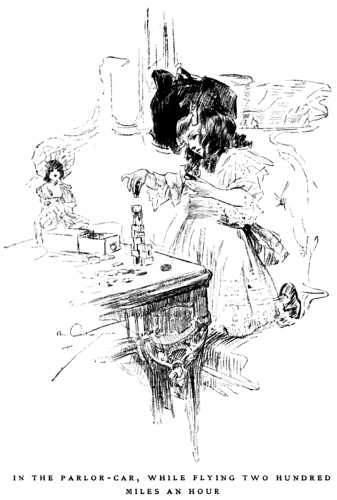 With this poor apparatus Brennan
came all at once to the solution of the first step in his problem.
Every one remembers that When, as a child, he threw down a top,
it often struck so that it spun at first at an acute angle with
the walk. Then it invariably righted itself. It forced itself
upward—that is, away from the friction on one side of its
point to the one position where the friction was equal on all
sides. In doing this it followed a familiar law of revolving bodies. With this poor apparatus Brennan
came all at once to the solution of the first step in his problem.
Every one remembers that When, as a child, he threw down a top,
it often struck so that it spun at first at an acute angle with
the walk. Then it invariably righted itself. It forced itself
upward—that is, away from the friction on one side of its
point to the one position where the friction was equal on all
sides. In doing this it followed a familiar law of revolving bodies.
Brennan, when he remembered this, did a very ingenious thing.
He practically made his revolving balance-wheel a top. The balance-wheel—standing
vertically in the car—was incased in a frame fastened to
the car-body. Through this frame he extended the wheel-axles on
either side, leaving their ends free and unfastened. These axle-ends
corresponded to the point of the top. Brennan then built out a
projecting segment from each side of the car just below the end
of each axle, to form a basis for the axle to spin on that is,
to correspond with the surface on which the top spins.
Now, when the car went about a curve, centrifugal action started
to throw it outward from the track. As it did this, the car began
to tip over, and the side of the car on the inside of the curve
rose. This brought up the little projection on the car-body till
it touched the end of the horizontal axle of the balance-wheel.
Immediately the balance-wheel started—exactly as a top would
do—to rise upright on the end of its axle, upon the surface
of the projection. To do this it must lean toward the inside of
the curve and, of course, exert its power to draw the car with
it. In other words, the moment the car struck a curve, the balance-wheel
caused it to lean inward instead of outward upon it.
This device overcame the familiar law of centrifugal force
which tends to pull all railroad trains off the track at curves.
But there remained a still greater problem. It was not only centrifugal
force which tended to drag Brennan's car off the track upon a
curve: it was his balance-wheel itself—the very thing which
kept it on the straight track.
If you take a gyroscope, fasten one of its axles, and whirl
it about at arm's length, one thing always occurs. The gyroscope-wheel
starts to revolve in the plane of the greater circle described
by your arm. This is another fixed law of revolving bodies; the
most familiar example of it is seen in the revolution of the earth
around the sun. Now, when Brennan's car came upon a curve, his
revolving balance-wheel was, in effect, seized upon by a greater
force and whirled about a greater circle. The wheel could do but
one thing: it must revolve in the plane of the greater circle;
that is, as the balance-wheel of the car was spinning in an upright
plane on the straight track, when it turned the curve, it tried
with all its power to turn over into a horizontal plane-in other
words, to throw the car over upon its side.
The Double Balance-wheels a Final Solution
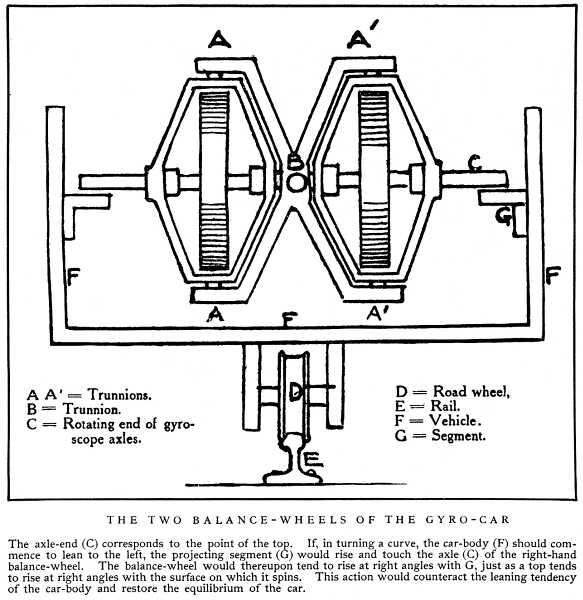
After months of thought, the solution of this trouble came
to Brennan in a flash. He used this law of a revolving body to
defeat itself. To understand, you must understand the whole law.
A revolving body forced into a greater circle not only must revolve
in the same plane as this greater circle—it must always itself
spin in the same direction as it is swung in that greater circle.
That is, if it is being swung from right to left in the greater
circle, it must itself spin from right to left—never from
left to right. To get into this new path of rotation, the wheel
takes the shortest possible way.
For example, if the balance-wheel of Brennan's car were revolving
forward like an ordinary car-wheel, in the direction in which
the car was moving along a straight track, and the car turned
a right-hand curve, the balance-wheel would turn over toward the
left, because in that way it would come to revolve in the same
direction as it swung in the great circle of which the curve was
a part. But if this balance-wheel were turning in the opposite
direction when the car was on the straight track, that is, backward,
it would turn over on this curve to the right. In other words,
two wheels revolving in the same plane, but in opposite directions,
turn over in exactly opposite directions when they are forced
to revolve in the plane of a greater circle.
Brennan immediately, applied this law. Instead of one balance-wheel,
he put two into his car—each revolving in the opposite direction
from the other, both, of course, along the plane of the track.
The tendency of one wheel to turn over at a curve exactly counterbalanced
that. of the other to turn over in the opposite direction.
Brennan's car would now move or stand still upon a single rail
under all conditions. The two balance-wheels held it upright on
a straight track; on the curves each neutralized the side pull
of the other. But on the curves the first device—the adaptation
of the action familiar in a top-still operated on the balance-wheel
nearer the inside of the curve, and this wheel tended to draw
the car inward.
The Resistance to a Sudden Weight
It did more than that, this latter device: it was an arrangement
by which, when weight was shifted unevenly in the car, the force
of the gyroscope rose up immediately to meet it. A weight on one
side of the car presses that side down. As it does this, the opposite
side is raised, and the projection strikes the end of the
axle of the balance-wheel. Again the friction on the end of this
axle works like the friction on the point of the leaning top.
The balance-wheel rises and leans away from the side on which
the weight is placed. The gyroscope becomes an automatic balancing-machine,
continually alert, quicker than human thought. At last, after
twelve years of groping and waiting and fighting, the gyro-car
on its mono-rail had been born into the world.
In the last few months Mr. Brennan has shown his model gyro-car
on several occasions, besides his exhibition before the Royal
Society on the evening of May 8, 1907; and demonstrations on a
large scale have been made at the inventor's country place near
Chatham, where he has laid single-rail tracks over his spacious
grounds, with grades, curves, bridges, in fact, a diminutive reproduction
of ordinary railroad conditions and some extraordinary ones.
The Recognition of High Authorities
The impression made by these demonstrations on the scientific
and mechanical world has been marked. The foremost engineering
authorities of England—such men as Sir John Wolfe Wolfe-Barry,
builder of the famous Tower Bridge, and Professor John Perry of
the Royal College of Science, South Kensington—have made
a careful study of this invention and have reported favorably
on it; the British War Office—a cold-blooded body not at
all inclined to give up money easily—has recently, on the,
advice of its experts, appropriated for Mr. Brennan the sum of
six thousand pounds to enable him to build a large mono-rail car
on the plan of his present small model, and has offered him the
use of the government torpedo factory at Chatham for the pursuit
of his mono-rail experiments, in which he will have imported military
assistance.
Not only is the War Office actively supporting the inventor
with a view to, using his mono-rail system for military purposes,
but the great railroad managers of South Africa have been quick
to appreciate the importance of one-rail lines in the vast and
sparsely settled regions of the Dark Continent. As a single instance,
the assistant chief engineer of the Central South African Railways,
after studying the workings of Mr. Brennan's single-rail car,
wrote to him on May 11, 1907, saying: "I was so much impressed
with the possibilities of your invention that in my report to
the general manager I stated that your invention would in the
near future revolutionize traveling. I suggested an overland (mono-rail)
route from the Rand, starting from Johannesburg and running in
a northwest direction to Victoria Falls through the Kongo Free
State, skirting Lake Chad, then traversing Morocco to Tangiers.
The journey from the Rand to London could thus be easily made
in six days instead of twenty-one, as now in force."
A Picture of the Model Car
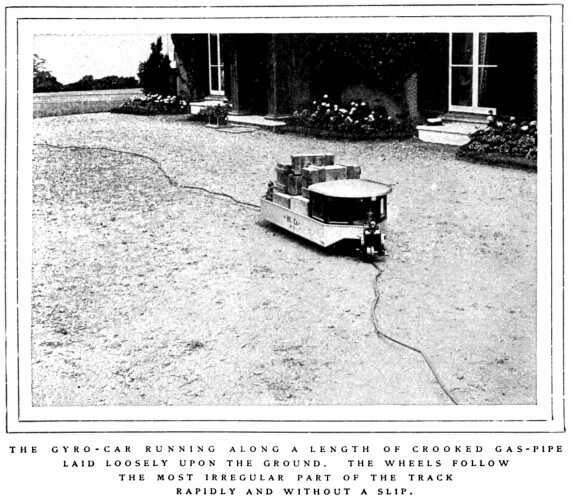 Before describing a typical demonstration,
I may explain that the model gyro-car is about five feet long
and a foot and a half wide. It is pointed at the two ends like
a torpedo, and rests on two trucks fore and aft, with wheels placed
tandem and grooved to run over a single track of gas-pipe or wire
rope. The model is beautifully made of aluminium with brass trimmings,
and weighs one hundred and seventy-five pounds without any load.
At the forward end are the balance-wheels, in a neat observation-room
fitted with glass windows and mahogany frame; at the rear end
are batteries to propel the car and turn the wheels. The rest
of the space is used for the load, either iron ballast or an actual
human passenger. Two letters stand out on the shining side of
the car — Before describing a typical demonstration,
I may explain that the model gyro-car is about five feet long
and a foot and a half wide. It is pointed at the two ends like
a torpedo, and rests on two trucks fore and aft, with wheels placed
tandem and grooved to run over a single track of gas-pipe or wire
rope. The model is beautifully made of aluminium with brass trimmings,
and weighs one hundred and seventy-five pounds without any load.
At the forward end are the balance-wheels, in a neat observation-room
fitted with glass windows and mahogany frame; at the rear end
are batteries to propel the car and turn the wheels. The rest
of the space is used for the load, either iron ballast or an actual
human passenger. Two letters stand out on the shining side of
the car —
"W. D." (War Department).
A Demonstration on the Inventor's Lawn
And now for the test. A dozen of us are waiting on the lawn
of Mr. Brennan's home—railroad men from South Africa, financial
men from London, and others. We have had the invention explained
to us in a general way, and at last we are to see it.
"Let her go," says the inventor to one of his assistants,
and straightway from beyond the trees a strange little object
shoots out and comes gliding toward us. It makes no noise; it
shows neither smoke nor steam; it does not bump, it does not sway;
it simply comes straight along on its little track over the grass,
very smoothly, and flashing in the sun. It is the gyro-car on
its mono-rail!
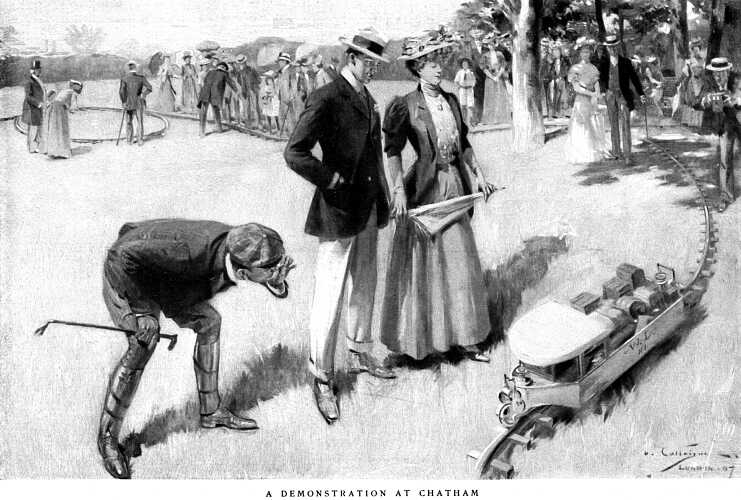
As she comes closer we hear the low hum of her hidden gyroscopes
(they will be quite noiseless in the larger model), and are struck
by the car's remarkable width in proportion to her, length. She
suggests a trim little ferry-boat, and is utterly unlike any known
form of railway car. Now the track curves sharply to the right;
she takes the turn with the greatest ease, and leans slightly
toward the curve. Now the track turns again, and she glides behind
the bushes. Coming out on the other side, she enters bravely on
the approach to a mono-rail suspension-bridge, a wire rope stretched
over the valley that falls away between two small hills—seventy-odd
feet of tight-rope-walking for the little car. Straight across
she runs from side to side,—no wavering, no tipping,—and
then straight back again as the assistant reverses her; then out
to the middle of the rope, where they stop her, and there she
stands quite still and true, while the gyroscopes hold her. This
is something never yet seen in the world a mass of dead matter,
weighing as much as a man, balancing itself unaided on a wire!
Weird Feats of Balancing
Now Mr. Brennan catches hold of the rope and sways it back
and forth with the car on it. And at each change of angle she
rights herself easily, automatically. The inventor draws back
his arm and strikes the car a hard blow on its polished side with
his open palm. And the car holds quite steady; she neither sways
nor trembles.
"That represents the greatest force of the wind,"
he tells us. "There is no hurricane strong enough to blow
one of my trains off a track like that."
Then he lifts one of the weights from the car and bids us note
what happens.
"These weights are all measured to a scale, and this one—really
about fourteen pounds represents three tons on a full-sized car;
I mean it has the same effect on this small car that three tons
would have on a large one. Now, look!"
As he spoke he dropped the weight on the very edge of the little
model, and the car rose slightly on that side under the sudden
load.
"That," he continued, "was exactly as if forty
or fifty passengers in a large mono-rail car had jumped at the
same moment from the middle of the car to the extreme edge of
it. As you saw, the car simply rose to meet the shock, which is
what she would always do speaking, of course, within the limits
of safe loading and safe construction."
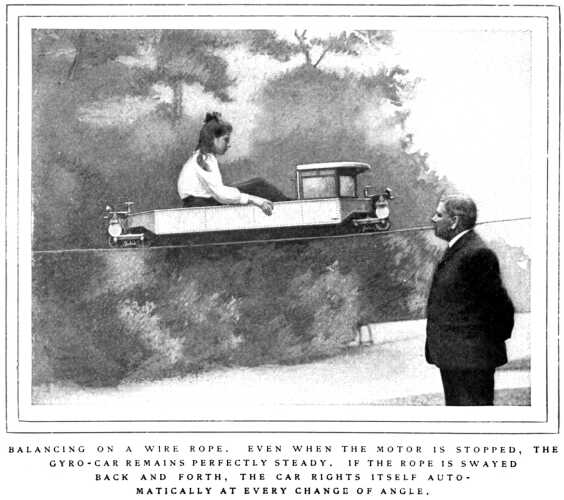 To impress us further with the
steadiness and safety of the little car, Mr. Brennan ran it back
to solid ground and, seating his little daughter in it, he sent
her forth upon the rope, ran her across and back, and finally
brought her to rest in the middle, with a drop of six or seven
feet beneath her. There she sat as calmly and steadily as if it
were the most natural thing in the world for young ladies to take
the garden air balanced on wire ropes. To impress us further with the
steadiness and safety of the little car, Mr. Brennan ran it back
to solid ground and, seating his little daughter in it, he sent
her forth upon the rope, ran her across and back, and finally
brought her to rest in the middle, with a drop of six or seven
feet beneath her. There she sat as calmly and steadily as if it
were the most natural thing in the world for young ladies to take
the garden air balanced on wire ropes.
After this the assistants switched the car on to a length of
gas-pipe lying loose upon the ground, so crooked and full of kinks
and sharp bends that it seemed absurd to expect wheels to run
over it. But run over it they did, and rapidly, too, picking their
way from right to left, up and down, following the crookedest
part of the pipe with almost human intelligence, and never making
a slip.
"That represents the worst possible railroad-track,"
laughed Mr. Brennan, "and you see how the car follows it."
Next the assistants produced a frame of heavy timbers across
which a wire rope had been stretched so that, when the frame was
held upright, the rope was parallel to the ground and three or
four feet above it. On this rope the car was placed and left to
balance itself at rest. Then the assistants, one at either end,
moved the frame back and forth, so that the car was first far
to one side of the perpendicular and then far to the other side—in
other words, so that it had to perform a delicate feat of balancing
and self-adjustment or else crash to the ground. And the car did
what was expected of it, thanks to the whirling balance-wheels,
without the slightest difficulty.
These were the most impressive features of the demonstration,
although the car did various other things: it climbed difficult
grades of one in five; it ran along the side of a steep hill on
a track laid over driven piles; it patiently and accurately followed
all manner of turns and curves; it stood still obediently at any
point and allowed its heavy load to be shifted as desired. In
short, it did more tricks in advanced railroading than any train
in the world ever dreamed of, or than any railroad manager would
believe possible unless he knew about these Brennan miracles.
After the test Mr. Brennan answered the different questions
put to him touching his invention and spoke of its future.
The Size and Revolutions of the Balance-wheels
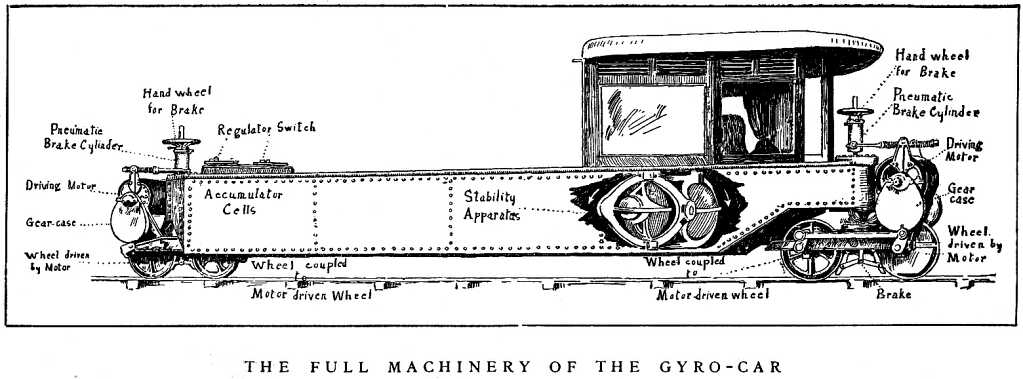
"How fast do your gyroscope-wheels turn?" inquired
one gentleman.
"In the present small car about seven thousand times a
minute," he replied, "but in the full-sized car of commerce
I calculate that three thousand revolutions a minute will insure
absolute steadiness. You understand that the two gyroscopes are
geared together with teeth, so that they must work in phase—that
is, at the same rate of precessional rotation."
"What will be the dimensions of a full-sized car?"
I asked.
"Its length will be about two hundred feet and its breadth
about thirty feet," answered the inventor, while our looks
of wonder grew.
"And its weight?"
"Perhaps a hundred tons."
"Without a load?"
"Yes."
"I suppose there will be several such cars in a train?"
"Yes, five or six."
"And you think you can balance five or six cars weighing
a hundred tons each without passengers or freight, on a single
rail?" put in a South African official.
"I know I can. You have seen what the model does. Well,
the full-sized cars will do the same, only better. I am now building,
with government aid, a trial car, forty-five feet by twelve, that
will carry two hundred passengers with absolute ease and steadiness."
"They will weigh about two tons each, or four per cent.
of the car's total mass, which is allowing a wide margin of safety.
I think one or two percent will ultimately prove sufficient. And
this weight of the gyroscope-wheels will be more than saved by
lightness of construction made possible by lessened strain on
the cars."
Suppose the Wheels Should Stop!
Mr. Brennan then dwelt on the enormous advantages of a single-rail
system in the matter of lessened friction and side-thrusts and
the consequent superiority in speed and smooth running—all
of which was readily granted by the railway experts, who also
agreed that a train would run securely on a single rail so long
as the gyroscope-wheels kept turning. But suppose something happened
to these? Suppose one of them stopped or both of them stopped?
Then what would become of a hundred-ton car poised on a single
rail and suddenly deprived of its balancing power?
"As you may well suppose," replied Mr. Brennan, "that
is a matter that I have considered carefully. Suppose the electric
power that drives these wheels were suddenly cut off. Do you know
what would happen? Nothing. Because the wheels revolve in a vacuum,
and on such perfectly poised bearings, with such ideal lubrication,
that—even with the driving power cut off—they would
continue to turn, by their own momentum, for two or three
days, and for two or three hours they would turn with sufficient
energy to hold the car safely balanced. That is, they would turn
long enough of themselves to provide for any reasonable emergency."
"Then each car in a train would be balanced by its own
balance-wheels?" asked some one.
"I have provided an automatic signal to warn the engineer
of such danger, at notice of which he would at once run the train
into a safety siding. There would be many of such sidings with
dwarf walls to support the cars, or the sides of the cars might
slightly overlap the walls."
"That is all very well," persisted the South African,
"but suppose one of the gyro-scope-wheels did absolutely
stop—broke loose from its bearings, or anything you like;
suppose it stopped instantly before the train could possibly reach
a siding. 'Then what?"
"Unless the car chanced to be on a curve at that precise
moment, the other wheel would hold it steady."
"But suppose the car was on a curve? Or suppose both
wheels stopped suddenly?"
Mr. Brennan smiled.
"Then there would certainly be an accident, just as there
is when a boiler bursts or an elevator falls or an automobile
gets in a smash-up. I do not claim that my mono-rail system does
away with danger. I only claim that through lessened friction
and lessened strain, which means lessened chance of accident and
derailment, my system involves less danger than our present methods
of railway transportation."
There followed some talk, more or less technical, about the
actual construction of a mono-railroad, with details as to the
weight of rails, the length of ties, the best way of laying tracks
along a stony mountainside, and much about grades and pile-driving
and concrete foundations. The South Africans were becoming practical;
and they were interested to know how these mono-rail cars would
come to rest in vast, sparsely settled regions, where they might
be used for pioneer or military work, and where there would certainly
be no safety sidings to support them. Mr. Brennan explained that,
in such cases, the cars would be provided with adjustable legs
that could be let down on either side when the gyroscopes were
not in use.
Finally, the hour having advanced, the company departed for
London, deeply impressed with what they had seen and heard. I,
however, was honored with an invitation to stay for further talk,
and, in the course of the evening, Mr. Brennan pictured for me
the wonderful things that are to result from his invention.
And here I asked many questions. Would all of his cars be pointed
fore and aft like the model? Oh, no; only the front and rear cars
would be pointed; the others would be oblong, but vestibuled together,
so that the train would look like a great transatlantic liner,
without masts or smoke-stacks. And the cars would be built of
enameled steel, with windows flush with the sides, and all the
surfaces free from projections and smooth as a bird's wing, so
as to give the least possible resistance to the air in swift flight.
"Six cars two hundred feet long," I reflected. "That
makes a length of twelve hundred feet for your vestibuled train?"
"Exactly."
"And a width of thirty feet?"
"About that."
"And a weight of a thousand tons—counting the load?"
"At least."
"All balanced on a single rail?"
"Yes."
I was silent awhile. What could one say to a picture like that?
"What power will drive these great trains?" I finally
asked.
"Any power you like—steam, electricity, gasolene.
The gyroscopes will balance the train as well with one as another."
"And such trains will cross wide rivers like the Hudson
and the Mississippi?"
"Of course, if bridges are there."
"How about speed?"
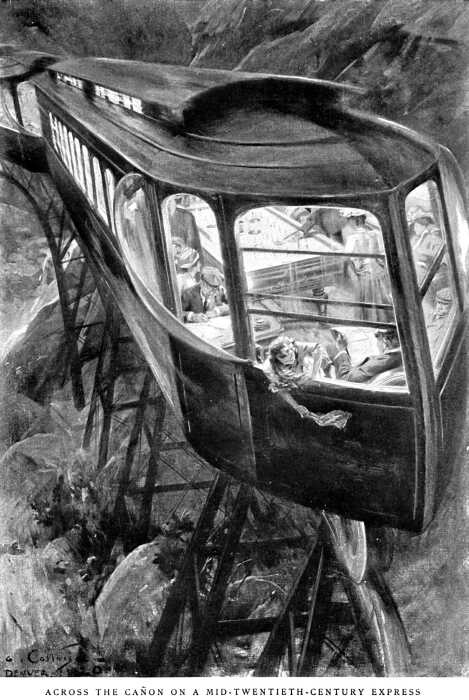 "In speed we shall surpass
all that the world has known; for with friction reduced to a minimum
and side-thrusts practically eliminated, there is no reason why
our mono-rail trains should not make one hundred and twenty, one
hundred and fifty, or even two hundred miles an hour with absolute
steadiness and far more safety than is possible on existing trains.
I may add that ideal smooth running will be secured by having
a continuous line of wheels under each car, a single line, of
course, so that the whole train will rest on a solid chain of
wheels." "In speed we shall surpass
all that the world has known; for with friction reduced to a minimum
and side-thrusts practically eliminated, there is no reason why
our mono-rail trains should not make one hundred and twenty, one
hundred and fifty, or even two hundred miles an hour with absolute
steadiness and far more safety than is possible on existing trains.
I may add that ideal smooth running will be secured by having
a continuous line of wheels under each car, a single line, of
course, so that the whole train will rest on a solid chain of
wheels."
To San Francisco in a Day
"Two hundred miles an hour!" I said. "That will
mean the run from New York to San Francisco in a single day?"
"Easily. And pleasantly, too; for you must bear in mind
that these cars will be different from any cars thus far known.
They will not be cars at all, but great, beautiful parlors, where
we shall travel almost without knowing that we are traveling;
where we shall find the comforts and luxuries of a first-class
hotel, brilliant dining-rooms like saloons on the best ocean liners,
spacious libraries and smoking-rooms, entertainment-rooms for
music or dancing, and, of course, large, well-ventilated sleeping-rooms
instead of the wretched bunks behind dusty curtains."
"All that," I reflected, "because these trains
will be wide and not narrow, as a train must be that runs on two
rails."
"Exactly. You see, the gyroscope will balance a wide train
as well as a narrow one, and what we gain by that fact in comfort
of passengers and facilities for carrying large quantities of
freight is beyond calculation. Our trains will have all the advantages
of a great steamship and none of the disadvantages." "On
a single rail," I added. "Yes," said he.
Oddities
| Contents Page
|







